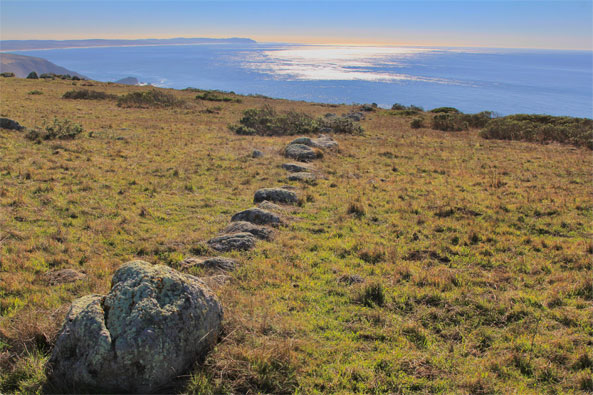
Tomales Point
| Status | Endangered |
| Country | United States |
| Report By | Lou-Anne Fauteck Makes-Marks, Ph.D., and Stephen D. Janes, Ph.D. |
| Posted | January 17, 2023 |

We need to know the truth about Native American prehistory, and indeed that of the Western Hemisphere. I personally feel that unless and until we are in some way connected with world history as early peoples . . . we will never be accorded full humanity. We cannot be primitive peoples who were suddenly discovered half a millennium ago.
—Vine Deloria, Jr., Indians, Archaeologists, and the Future (1992, p.597)
Tomales Point and Point Reyes, the Farallon Islands and the West Berkeley Shellmound, all in northern California’s Bay Area, are sacred places. Their entirety forms an immense ceremonial and mortuary complex for the Coast Miwok and Ohlone, indigenous to the San Francisco Bay Area. These coastal sites are evidence of early Polynesian settlement in the Americas.
They are presently threatened with substantial damage and destruction—and they should be protected and preserved. The Farallon Islands are facing a proposal by Point Blue and the U.S. Department of the Interior’s Fish and Wildlife Service that includes a 1.5 ton Brodifacoum poison drop to kill mice on the islands. This poisoning will cause irreparable harm, with bykill spreading to the surrounding marine sanctuary and affecting massive numbers of fish, birds, other wildlife, and the food chain up and down the coast and inland. Brodifacoum is a blood thinner, causing animals ingesting it to bleed to death. The California Coastal Commission approved the poison drop on a conditional basis for fall 2023.
Tomales Point and Point Reyes are facing continued archaeological site degradation and massive environmental damage from groundwater pollution from commercial grazing leases to private ranchers. The restored native tule elk there continue to be threatened with removal and extermination to allow expanded cattle grazing. The National Park Service did not follow through on the 2008 nomination of a Coast Miwok heritage district (see footnote 1, below) at Point Reyes National Seashore to the National Register of Historic Places. Instead, in 2012, the Drakes Bay Historic and Archaeological District was approved (2). In 2015, the nomination of the Indigenous Archaeological District was withdrawn and replaced with the Historic Dairy Ranching District (3).
The West Berkeley Shellmound and Village Site was declared a historic landmark by the City of Berkeley in 2000. In 2020, the National Trust for Historic Preservation listed the West Berkeley Shellmound site as one of the eleven most endangered historic places in the United States on their annual list. Excavation and construction of a commercial and residential building are threatening the site, with an ongoing legal battle, despite the site’s cultural significance, landmark status and support by the City of Berkeley.
Indigenous California Astronomers
On the central coast of California, a megalithic archaeological site has been discovered at Tomales Point on the Point Reyes Peninsula. Structures composed of massive rocks weighing several tons are assembled there. Its features include two stone lines—together approximately 846.5 feet long and crossing the crest of the Tomales Point ridge, isolated standing stones and upright stones within the lines, raised earthen platforms, a roundhouse foundation, and a spring. Rounded boulders perched on stone piles are arranged to mimic the constellation Cassiopeia in the night sky.
Confirmation that the builders of these structures regularly visited and used the site came with the discovery of the roundhouse and platforms. The presence of this star map and many other cosmological connections between the structures suggest that the site apparently was built for regular astronomical observation and ceremonies. The west face of the largest standing stone at the site is marked by a large petroglyph of a star, further supporting the astronomical/ceremonial function hypotheses.
Ceremonial and Mortuary Complex
The oral traditions of the Coast Miwok, indigenous to this area, confirm that the site of the stone line, just off the coast, was used as Jumping-Off Place for the spirits of the dead, on their way to the Farallon Islands (4), which could be both a resting place of the spirits and a last Earth point before journeying to the Milky Way. The roundhouse, platform mounds, and other features were used in ceremonies.
Coast Miwok are related to the Ohlone, their neighbors, by language, culture and DNA. The Ohlone’s West Berkeley Shellmound has functioned for thousands of years as a similar portal for the spirits of the dead, who jump off the island of Alcatraz to fly to the Farallon Islands.
These sites are connected to other sites, including a Jumping-Off Place at Mount Saint Helena.
The Miwok and Ohlone also share “geomorphic theophanies,” which is when spirit beings, often mythic characters from Indigenous traditional stories, are felt to be alive in and mapped as landscapes. Geomorphic theophanies are common in the Americas as well as other places in the world. The San Francisco Bay Area includes Coyote, his Flea/Shrimp wife, Hummingbird, Eagle/Condor, and Pelican as geomorphic theophanies.
Polynesian Connections
Jumping-Off Places like these have only been located in Polynesia (5), where they are pervasive, and along the coast of the Americas, including at Point Conception in southern California at a site honored by the Chumash and other tribes.
The presence of a Jumping-Off Place, along with other cultural, archaeological, linguistic, and genetic evidence, support that these Bay Area sites represent early Polynesian settlement in the Americas. Multiple other researchers have previously presented abundant research to support the conclusion of Polynesian contact on the Pacific Coast of what is now North and South America.
Community roundhouses were in use historically around the world and are still in use in central California and South America. Standing stones were known in California, Pacific Island cultures, India, and elsewhere. Features of the Tomales Point site and the Chumash site at Point Conception are comparable to early Polynesian ceremonial spaces.
The Farallon Islands were respected as a shelter for the spirits of the dead, a place where some reincarnated as birds, a home for Coyote, and a stopping point on spirits’ journeys to join the stars. Human remains may have been preserved in the islands’ network of caves, some now underwater, as cave burials were common in Polynesian cultures.
Early Settlement on the Pacific Coast
Linguistic research in the 1980s on the Miwok and Ohlone’s shared Penutian languages supported a hypothesis of early Pacific coastal settlement. Gruhn estimated Pacific settlement to be 35,000 years before present, with population movement fanning out inland. She based her estimate on Fladmark’s proposal for a coastal migration by boat (7). His coastal route theory became accepted in the intervening decades: “Most archaeologists now believe the first Americans traversed the Ice-Free Corridor or a Pacific Coast route, or both, during the terminal Pleistocene.” (8)
In genetics, central California was identified as a potential location for the founding event for mitochondrial (mt) DNA haplogroup B2 (B4b2), found in many Indigenous American populations below the Arctic Circle. Johnson and Lorenz concluded that samples of Sierra Miwok and Patwin mtDNA were representative of the founding haplotype proposed for mtDNA haplogroup B2 in North America (9). A Pomo, whose tribe is a neighbor to the Miwok, was later identified as being in the haplogroup founding lineage (10): “The data suggest that B2b [B4b2b] could have arisen in North California (an origin even in the north most region of the American continent cannot be disregarded.” (11)
When mtDNA locations are heat mapped (12), the spread of B2 is depicted as fanning out from its Pacific Coast origins into North America (see map below). A comparable fan for mtDNA B2 is found in South America from coastal settlement there. Very little B2 is has been located above the Arctic Circle, potentially ruling out Beringia as a migration passage.
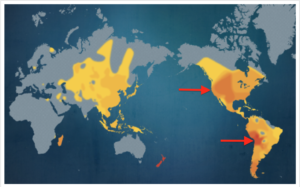
Global heat map of mtB2, Source: Genographic Project Heat Map, mtDNA Haplogroup B4, National Geographic Society (Estes 2017).
This evidence also supports early trans-Pacific route settlements on the Pacific coast of the Americas.
Initial settlement on the central California coast was earlier than current archaeological estimates allow. However, research has recently confirmed more generous dating of other early archaeological sites in the Americas than in the past. Dates are being moved further back in time. Previously unknown Australasian DNA traces have been found in Indigenous populations on the South American Pacific coast and in Amazon regions (13). Cranial morphological testing indicated comparable results (14).
Contemporary Coast Miwok lineal descendants show traces of South Indian/Australasian/Polynesian DNA in preliminary testing. Cultural traits of Coast Miwok and Ohlone are similar to those of South India, Australasia and Polynesia. Other Penutian-speaking people, like the Winnemem Wintu, whose sacred homelands are currently threatened by the proposed raising of water levels behind Shasta Dam, also share in this same heritage. The Tamil of South India have been identified as being genetically, culturally, and linguistically related to Coast Miwok and Ohlone. Like the Tamil, there are Tamal people among the Coast Miwok, and Mount Tamalpais is in Marin County, to the east and close to Tomales Point.
Polynesian Star Maps
Early navigation and trade by boat in the Indian and Pacific oceans was common, especially among South Indians, Australasians and Polynesians. Navigation was made possible by observation and knowledge of the ocean and the stars.
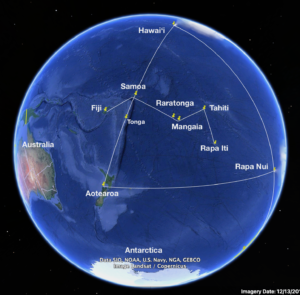
“Polynesian Islands Cassiopeia,” Source: Lou-Anne Fauteck Makes-Marks, Google Earth Pro
There is a known triangle of stars that maps islands of the Polynesian Triangle in the ocean. A star map of Cassiopeia was also used to map islands in western Polynesia. There is evidence that Polynesians first explored and recorded, then star mapped, and then intentionally settled these star-mapped areas. They obviously mapped the Pacific Coast of the Americas by the stars, where early coastal settlements have been found to correspond to the stars’ locations. Star maps are known to exist elsewhere in the Americas as well.
There are Indigenous oral traditions and other, prior evidence of Polynesian presence and migrations from the west. An example is the Hopi creation story in which the Third World was destroyed by flood and people came to North America in reed boats from the west (15).
The Farallon Islands correspond to the location of the North Star on Polynesian star maps. These islands were once the highest point of a large mountain range at the western edge of the continental shelf. They are the most likely landmark and landfall for early South Indian, Australasian and Polynesian settlers on the central California Coast.
These Sacred Places Need Your Help
Tomales Point and Point Reyes, the Ohlone West Berkeley Shellmound on San Francisco Bay, and the Farallon Islands are all presently threatened with substantial damage and destruction. They are sacred places, and they should be protected and preserved.
Learn What You Can Do
Point Reyes
MEDIA RELEASE: Actor Peter Coyote Speaks Out for Tule Elk of Point Reyes National Seashore
PROTECTING POINT REYES TULE ELK
Lawsuit Challenges Point Reyes Ranching, Elk-Killing Plan
Farallon Islands
CITIZENS SPEAK! Stop the Poison Drop at the Farallon Islands.
Stop Massive Poison Dump on Farallon Island Owls & Mice
SPECIES SPOTLIGHT: THE FARALLON CAMEL CRICKET
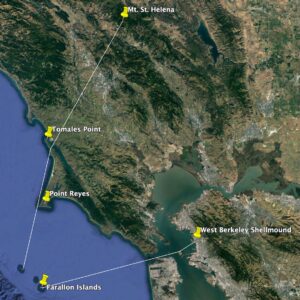 Stop Massive Poison Dump on Farallon Islands Video
Stop Massive Poison Dump on Farallon Islands Video
West Berkeley Shellmound
Dancing on the Edge of the Pacific
Shellmound, Ohlone Heritage Site and Sacred Grounds.
City of Berkeley and Lisjan Tribe Appeal Shellmound Case to CA Supreme Court
Write a letter in support of preserving the Shellmound
Donate to the Shellmound Defense Fund
About the Author
Lou-Anne (Luan) Fauteck Makes-Marks, Ph.D., is an independent researcher and activist for Indigenous American sacred lands and places. She is mixed blood by heritage, including European, Asian, Coast Miwok, Kashia Pomo, Kamchadal Aleut, Creek, Shawnee, Virginia and Maryland Algonquian, and Southeastern Sioux. She holds an MA in Consciousness Studies, an MFA in Fiber and Mixed Media Arts, and a Ph.D. in Philosophy and Religion.
Footnotes
1. Center for the State of the Parks 2009, p12.
2. Drakes Bay National Historic Landmark Dedication
3. National Park Service Terminated Coast Miwok Archeological Protection Plan in Favor of Subsidizing Private Ranching at a National Seashore
4. Collier and Thalman 2003, p450; Gardner 2007.
5. See, as examples, Pogue 1858, p30; Kamakau 1870, p47-48; Thomson 1896, p420; Emerson 1907, p50; Dibble 1909, p82; Fornander, in Thrum 1916-1919; Handy 1923, p252; Beckwith and Green 1926, p187; Mitcalfe 1961; Beckwith 1970, p154-158; Pomare and Cowan 1987, p48-52; Anderson 2020, p23-24.
6. 1988, p77.
7. 1975.
8. Braje, Erlandson, and Torben, et al. 2020, p2.
9. Johnson and Lorenz 2006, p48.
10. Taboada-Echalar, Álvarez-Iglesias, Heinz et al. 2013, p8.
11. Ibid., p1.
12. Estes 2017.
13. Skoglund, Mallick, Bortolini, et al. 2015; Moreno-Mayar, Vinner, and de Barros Damgaard, et al. 2018; Ribeiro-dos-Santos, Vidal, and Vinasco-Sandoval, et al. 2020; Castro e Silva, Ferraz, and Bortolini, et al. 2021.
14. Neves and Hubbe 2005.
15. Waters 1977, p25.
Sources Cited/Bibliography
Anderson, John M. 2020. Kuta Teachings: Reincarnation Theology and the Chumash Path of the Dead. 5th ed.
Beckwith, Martha.1970. Hawaiian Mythology. Originally published 1940. Honolulu, HI: University of Hawai’i Press.
Beckwith, Martha, and Laura C. Green.1926. “Hawaiian Customs and Beliefs Relating to Sickness and Death.” American Anthropologist 28: 176-208.
Braje, Todd J., Jon M. Erlandson, and Rick Torben, et al. 2020. “Fladmark +40: What Have We Learned about a Potential Pacific Coast Peopling of the Americas?” American Antiquity 85 (1), 1-21.
Castro e Silva, Marcos, Tiago Ferraz, Maria Cátira Bortolini, et al. 2021. “Deep Genetic Affinity between Coastal Pacific and Amazonian Natives Evidenced by Australasian Ancestry.” PNAS: 118:4.
Center for the State of The Parks. 2009. “Point Reyes National Seashore: A Resource Reassessment.” Fort Collins, CO: National Parks Conservation Association.
Collier, Mary E. T., and Sylvia B. Thalman, comps. and eds. 2003. Interviews with Tom Smith & Maria Copa: Isabel Kelly’s Ethnographic Notes on the Coast Miwok Indians of Marin and Southern Sonoma Counties, California. San Rafael, California: Miwok Archeological Preserve of Marin.
Deloria, Vine, Jr. 1992.“Indians, Archaeologists, and the Future.” American Antiquity 57:595-598.
Dibble, Sheldon.1909. A History of the Sandwich Islands. Originally printed 1843. Honolulu, Territory of Hawaii: Thos. G. Thrum, Publisher.
Emerson, J. S. 1907. “Hiku and Kawelu.” In Thrum, Thomas. G., comp. Hawaiian Folk Tales: A Collection of Native Legends. Chicago, IL: A. C. McClurg & Co.
Estes, Roberta. 2017. “New Native American Mitochondrial Haplogroups.” DNAeXplained – Genetic Genealogy. March 2.
Fladmark, Knut R. 1975. A Paleoecologial Model for Northwest Coast Prehistory. Ottawa: National Museum of Man, Mercury Series. Archaeological Survey of Canada, Paper 43.
Gardner, Gavin. 2007. “A Cultural Resources Study of the Spirit Jumping-Off Rocks Site, Point Reyes National Seashore, California.” Rohnert Park, California: Anthropological Studies Center, Sonoma State University.
Gruhn, Ruth. 1988. “Linguistic Evidence in Support of the Coastal Route of Earliest Entry into the New World.” Man. 23: 1 (March): 77-100. Royal Anthropological Institute of Great Britain and Ireland.
Handy, E. S. Craighill.1923. The Native Culture in the Marquesas. Honolulu, HI: Bishop Museum Press.
Johnson, John R., and Joseph G. Lorenz. 2006. “Genetics, Linguistics, and Prehistoric Migrations: An Analysis of California Indian Mitochondrial DNA Lineages.” Journal of California and Great Basin Anthropology 26:33–64.
Kamakau, Samuel Manaiakalani. 1870. Ke Au Okoa 6 (October 6).
Mitcalfe, Barry. 1961. “Te Rerenga Wairua: Leaping Place of the Spirits,” Te Ao Hu 35:38-42. Wellington, NZ: National Library of New Zealand, New Zealand Government, with permission of The Secretary Māori Purposes Fund Board.
Moreno-Mayar, J. Victor, Lasse Vinner, Peter de Barros Damgaard et al. 2018. “Early Human Dispersals within the Americas.” Science 362:6419.
Neves, Walter A., and Mark Hubbe. 2005. “Cranial Morphology of Early Americans from Lagoa Santa, Brazil: Implications for the Settlement of the New World.” PNAS.
Pogue (Pokuea), J. F., Rev.1858. Ka Moolelo Hawaii. Originally published 1838 by Sheldon Dibble. Honolulu, HI: Hale Paipalapala Aupuni.
Pomare, Sir Maui, and James Cowan.1987. Legends of the Maori 1. Originally published in 1930. Auckland, NZ: Southern Reprints.
Ribeiro-dos-Santos, André M., Amanda Ferreira Vidal, Tatiana Vinasco-Sandoval, et al. 2020. “Exome Sequencing of Native Populations from the Amazon Reveals Patterns on the Peopling of South America.” Frontiers in Genetics 11:548507.
Skoglund, Pontus, Swapan Mallick, Maria Cátira Bortolini, et al. 2015. “Genetic Evidence for Two Founding Populations of the Americas.” Nature 525:104-08.
Taboada-Echalar, Patricia, Vanesa Álvarez-Iglesias, Tanja Heinz, et al. 2013. “The Genetic Legacy of the Pre-Colonial Period in Contemporary Bolivians.” PLOS ONE 8(3): e58980.
Thomson, Basil.1896. “The Path of the Shades.” W. E. Henley, ed. The New Review. London: William Heinemann.
Thrum, Thomas G., ed. 1916-1919. “Fornander Collection of Hawaiian Antiquities and Folk-lore.” Memoirs of the Bernice Pauahi Bishop Museum, Memoir 4-6. Honolulu, HI: Bishop Museum Press.
Waters, Frank, and O. W. B. Fredericks. 1977. Book of the Hopi. Originally published in 1963. New York: Penguin Books.
Continue Exploring Sacred Sites
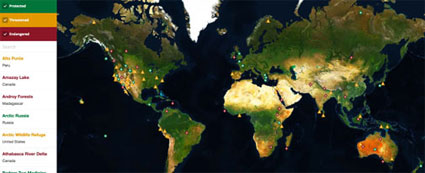 Explore a world of sacred lands and discover more than 100 site reports using our interactive map.
Explore a world of sacred lands and discover more than 100 site reports using our interactive map.